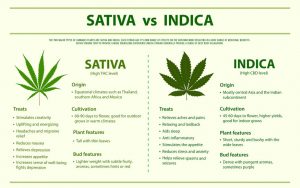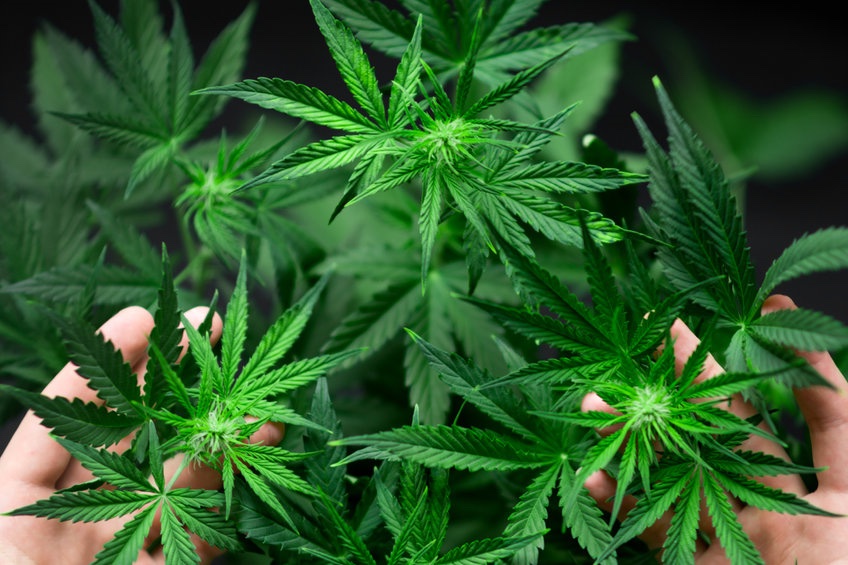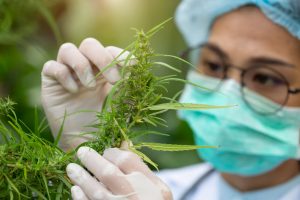There is still consumer confusion around cannabis despite its growth in popularity in recent years. Typically, a common misconception is that marijuana and hemp are separate species within the broader cannabis plant family. However, it is reported that the two different names are used to describe cannabis varieties, or stains, that produce different quantities of tetrahydrocannabinol (THC). The legislation uses the terms to profile different cannabis-based products and assign laws regarding the use and consumption of THC or cannabidiol (CBD) products. In the following article, we clarify several cannabis misconceptions and highlight the difference between weed and the flower. The following information will help you make an informed consumer decision the next time you browse for THC or CBD products.
What Is Marijuana?

Marijuana is the name generally given to cannabis-based products that contain more than 0.3% of THC by dry weight. THC is the psychoactive cannabinoid compound of the cannabis plant that is responsible for inducing an intoxicating feeling, or ‘high’ when ingested as an edible or smoked through various paraphernalia. Cannabis plants are grown using an array of agricultural methods to produce flowers, or buds, that contain varying concentrations of THC. The three primary cannabis designations under which the various strains fall are as follows:
- Cannabis sativa: often used recreationally to boost energy levels and improve creativity
- Cannabis indica: often used medicinally to relieve pain and promote proper sleeping patterns
- Cannabis ruderalis: usually included in medicinal CBD products for their high concentration of the cannabinoid and low concentration of THC
The Health Benefits Of Marijuana
The THC-concentrated buds of Cannabis sativa and Cannabis indica strains are said to offer individuals several health benefits that we have outlined in more detail below. There are several studies that support the various benefits, although there is still much research to be done into these proposed health properties. Whatsmore, marijuana consumption for medicinal value is similar to supplementation and every individual will experience varying reactions to THC-based products. For these reasons, consumers should assess the benefits against their personal experiences to make an informed consumer purchase. The following benefits are scientifically backed:
Helps Relieve Pain
The most commonly talked about benefits of the consumption of THC-based marijuana products is their ability to reduce and relieve pain in the muscles and joints. The compounds within cannabis that are consumed through THC products react with the body’s internal endocannabinoid system and attach themselves to receptors in order to deliver the proposed benefits. In terms of pain, studies highlight that marijuana may interact with the nervous system and work to reduce nerve pain. Other research indicates that cannabis consumers experienced reduced issues with and frequency of migraines. While more research needs to be done to have conclusive evidence of marijuana’s pain-relieving properties, the many studies in favor of this notion bode well for the hypothesis.
May Improve Lung Capacity
The most common consumption method of marijuana is smoking. Typically, smoking is associated with lung disease, heart disease, and other severe health conditions. Smoking marijuana, however, differs from tobacco as the combustion of THC releases a variety of natural and herbal substances and compounds. Studies into the effects of smoking marijuana on the body may indicate that marijuana smoking improves lung capacity rather than damages the lungs, reports that have been published by authority sources including Time magazine.
Prevents The Onset And Reduces Symptoms Of Diabetes
There is growing evidence that supports the notion that the consumption of marijuana and THC-based products may prevent the development of diabetes as well as reduce symptoms associated with the common health condition. These reports come from sources that suggest marijuana consumption helps to stabilize blood sugar levels, reduce blood pressure levels, and support proper blood flow and circulation around the body.
Supports Individuals That Experience ADHD
ADHD is a common mental health condition that affects millions of Americans and individuals around the world. Until recently, ADHD medication has been subject to skepticism and criticism regarding its ability to adequately support the needs of individuals experiencing the condition. Today, studies and reports are suggesting that the use of marijuana may be a beneficial and natural alternative to prescribed ADHD medication. While more research needs to be done before a conclusive decision can be made, this bodes well for the efficacy of marijuana in relieving symptoms of ADHD.
May Aid Depression
Another benefit of the psychoactive component of THC in marijuana may be its ability to aid depression and help individuals diagnosed with the condition deal with their struggles and anxieties. Studies aim to showcase marijuana’s potential to support patients with depression, and the results are positive. THC-based products may be used to stabilize one’s mood, support sleep quality and patterns, and reduce everyday stress which are common onsets of depression. While marijuana cannot cure depression, it may help alleviate the troubling symptoms associated with the health condition.
What Is Hemp?
Hemp is the name given to cannabis strains that produce less than 0.3% of THC by dry weight. The term hemp usually describes CBD-based products that derive from hemp seed oil, a byproduct of cold-pressing hemp seeds. As a result of containing very little THC, hemp seed oil CBD products should not induce a ‘high’ in the same way that high THC concentrated products do. Instead, hemp offers medicinal value and is often the key term used to describe products that are marketed by manufacturers in the health and wellness industry for their ability to offer several benefits.
The Health Benefits Of Hemp
Hemp-based products that contain high concentrations of CBD are used topically as a cream or oil, ingested as an oil, or cooked with food. In this way, hemp differs from marijuana flowers as the primary component used to manufacture the CBD products are the hemp seeds rather than the bud itself. The various uses of hemp CBD products are said to offer various health benefits according to scientific studies. The following information assesses these proposed effects according to research to give consumers a clearer idea of what makes these particular cannabis products popular holistic and alternative medicinal remedies:
Supports The Immune System
Hemp CBD oils contain several nutrients derived from hemp seeds that are said to support the immune system and other internal bodily functions. High levels of Vitamin E are typically found in hemp oils and this crucial vitamin is responsible for improving one’s immune functioning. As an antioxidant, Vitamin E reduces oxidative stress that would otherwise damage the immune system and encourages optimal cell division for stronger and healthier immunity. The anti-inflammatory properties of Vitamin E are also scientifically linked to better immune function according to authority sources.
Improves Cardiovascular Function
The presence of additional healthy substances, particularly Omega-3 and Omega-6 fatty acids in hemp oils are said to support heart health and improve cardiovascular function. Omega-3 and Omega-6 are primarily responsible for supporting the body’s ability to regulate cholesterol levels, reduce blood pressure, and balance blood sugar levels. Mayo Clinic also suggests that the consumption of high concentrations of Omega-3 and Omega-6 fatty acids decreases the presence of triglycerides which are known to harden the arteries.
Promotes Proper Reproductive Health
The consumption of hemp oil may promote proper reproductive health in women as the products are generally high in gamma-linolenic acid (GLA) concentrations. This specific compound is said to have several significant health impacts on reproductive health, helps manage menopause symptoms, and more. GLA’s ability to reduce the stress associated with the prolactin hormone may also help alleviate common symptoms linked to PMS.
Helps With Digestion
Digestive health is directly linked to fiber, and hemp oil is said to provide the body with high quantities of healthy fiber. The hemp seeds themselves contain soluble and insoluble fiber while the oils may extract enough fiber to support digestive health. The benefit of this increase in fiber is in the prebiotic qualities and influx of ‘good’ bacteria as a result of hemp oil consumption. The intake of fiber in this way may lead to a reduction in poor digestive health symptoms such as constipation, ulcers, and hemorrhoids.
Reduces Eczema
The topical use of hemp oil is said to promote healthy skin and reduce symptoms of eczema. This is linked to the fact that the oil contains several nourishing substances. Several studies into the effects of hemp on the skin highlight its ability to balance lipid levels in the body, reduce signs of dryness, and combat skin irritations such as rashes and redness. For these reasons, the topical application of hemp oil alongside a proper skincare routine should manage symptoms of eczema and other skin conditions.
The Difference Between Weed And Flower
Weed is the nickname given to cannabis plants that have high concentrations of THC and the flower is the bud from which the intoxicating THC compound is derived. Consumers of THC typically remove seeds and stems from the flower and then smoke it using rolling papers, an electronic cigarette, or a vaporizer. The THC compound from the flower can also induce psychoactive effects when ingested with food.
The Anatomy Of Cannabis
In order to better understand the difference between weed and flower, we unpack the anatomy of the cannabis plant and shed light on the various components that constitute the entire species. This will give you a clearer idea of the various proponents that are either used industrially to produce rope, clothing, and other items or medicinally for the health benefits associated with THC and CHD, or even recreationally in states where marijuana is deemed legal for recreational use.
Weed
Weed is a nickname given to cannabis plants, whether they fall into the marijuana or hemp category in the name of the law. Weed refers to the entire plant and all of the components that make up the plant. When individuals refer to weed, they are generally referring to the collective cannabis plant as a whole but may also interchange the term weed to refer to the flowers. This is the biggest misconception about the difference between weed and flower, and using the terms accurately gives individuals and marijuana and hemp product providers a better idea of what you, as a consumer, are specifically inquiring about.
Flowers
Commonly known as ‘buds’, flowers are the trichome-enriched ‘fruit’ that grows from the plant nodes. Flowers contain the cannabinoids associated with the health benefits of marijuana and hemp consumption, namely THC and CBD. Flowers are harvested from the dried weed plant and sold as a whole, cold-pressed to extract the CBD and THC to form hemp or marijuana oil, or used as a cook-in ingredient for individuals to receive the health or recreational effects in heavier and more pronounced doses. The flowers are the key component that is responsible for the many scientific discussions currently surrounding marijuana and hemp use.
Trichomes
Trichomes appear as shiny, crystal-like resin on the flowers. These trichomes contain and produce the sheer crystal dust that appears on the buds which are responsible for providing consumers with the CBD and THC benefits of hemp and marijuana consumption. Trichomes are also vital in the production of hash, a concentrated form of cannabis.
Seeds
Marijuana and hemp seeds are quite simply the seeds from which the weed plant grows. Marijuana plants produce seeds that are used to recreate a strain or are germinated with alternative strains to produce something new entirely. Hemp plants produce seeds that are generally cold-pressed to produce hemp seed oils. These hemp seed oils are generally high in CBD concentration and are consumed or used topically for the proposed health benefits associated with CBD products.
Roots
The main root that grows from a marijuana or hemp seed is called the ‘tap root’ and from it grows several additional roots that feed the plant nutrients for healthy growth. These roots serve as the life force for the cannabis plant growth and enable the production of seeds to be used for smoking or pressed as oils. Growers can add several types of substances to the soil in which the plants grow to stimulate healthier production, including the popular addition of the Mycorrhizal fungus.
Stem
The main stem is commonly referred to as the stalk and it is the branch from which the buds, leaves, and more cannabis plant components grow. This vertical branch supports the growth of cannabis and the production of horizontal branches that stimulate bud development. Various nodes appear on the stem, and growers may cut their marijuana or hemp plants after the appearance of several nodes to different effects and outcomes.
Branches
Horizontal branches grow from the main, vertical stem and are responsible for supporting the development and growth of leaves and flowers. Cannabis plants can be trained at various stages of growth by cutting and trimming the branches to manipulate the growth patterns of buds associated with a particular strain. Cannabis growing is an art that individuals are consistently trying to improve upon to deliver the best experience and health benefits with particular THC and CBD products.
Nodes
A cannabis node is the point of the main stem from which the branches grow. Nodes also appear on branches that split off, as well as where the fan leaves and buds develop from. Nodes can be used to determine the gender of the cannabis plant with a carefully trained growing eye.
Fan Leaves
The iconic cannabis leaves that have been used to symbolize marijuana and hemp for centuries are known as fan leaves. These leaves are not used for any particular medicinal or recreational purpose but may serve as a decoration element when cooking cannabis or seen as a logo on THC and CBD products. The leaves are responsible for absorbing the light needed for the growth of the plant.
Sugar Leaves
Buds typically form around the small, resin-coated leaves at the base of a branch that is known as sugar leaves. Sugar leaves do not offer enough THC or CBD to provide the health benefits of recreational associations of the cannabis plant, however, they can be used in combination with cannabis products to elevate the experience.
Cotyledon Leaves
The final type of leaves that occur during the growth of cannabis plants are cotyledon leaves. These are the first leaves that grow from the seed after germination and often grow in pairs with one another. The appearance of cotyledon leaves during the early stages of cannabis growth is a sign that the cannabis plant is growing healthily and should bear buds that can be harvested for CBD or THC-based products.
Cola
Cola is a term that refers to the clustered growth of buds, more commonly known as a ‘bud site’. The budding sites occur along the branches with the main bud site appearing at the top of the plant and often referred to as the apical bud.
Bract And Calyx
Green, tear-shaped leaves that form on the plant are known as bract and these encompass the primary female reproductive components of the cannabis plant. The bract contains a large quantity of resin and is high in concentration of cannabinoids. These bracts encase the calyx which is the transparent layer at the flower’s base that conceals the ovule.
Stigma And Pistil
The hair-like strands that come from the pistil, which contains the reproductive parts of the cannabis plant, are known as stigma. They begin white and grow progressively darker as the plant matures. Stigmas are an important component of cannabis reproduction but add little value to the medicinal or recreational consumption of cannabis and THC or CBD-based products.
Should You Use Marijuana Or Hemp?
Whether you are considering marijuana or hemp use for the associated health benefits, it is important to be aware of the legislation within your state. Do your research and clue yourself up on where marijuana and/or hemp stand in the eyes of your state’s laws and then begin to search for CBD or THC-based products that are legally allowed in your area. In the event of purchasing these products, you may experience the benefits associated with the consumption or topical application of marijuana or hemp oils. You may also see benefits when consuming THC and CBD-based products in several additional ways.
Where To Buy Marijuana Or Hemp
There are hundreds and thousands of marijuana and hemp product retailers based across the country, and you can freely browse their online stores in your search for an ideal cannabis product. In all instances, you should ensure that you purchase from a reputable and reliable manufacturer of CBD and THC-based products. Keep your eyes peeled for the following signs of quality assurance:
- Significant positive reviews that support the products ability to deliver on marketing claims made by the manufacturer.
- Evidence of studies or trials that would confirm the quality of the manufacturer, such as certifications and stamps of approval.
- Chat with a specialist via a manufacturer’s customer service line to get a stronger idea of what product will specifically work for you and your needs.
- Consult other cannabis consumers in your area via forums or social media groups to gauge the efficacy of specific products.
- Confirm with additional studies and reports that consider the benefits of CBD and THC products to affirm your decision and give you peace of mind regarding the products that you are browsing.
The Bottom Line
In summary, the difference between weed and flower boils down to the simple premise that weed refers to the entire cannabis plant while flower refers to the ‘buds’ that are used to consume the THC and CBD compounds associated with the health benefits of marijuana and hemp consumption respectively. There are a variety of studies that support the proposed benefits, including helping relieve pain, reducing symptoms of skin disease, supporting cardiovascular functioning, and improving the immune system to name a few. These benefits are dependent on one’s individual response to CBD and THC, so be sure to do your own further research and trials in order to make the most accurate and informed consumer choice.



